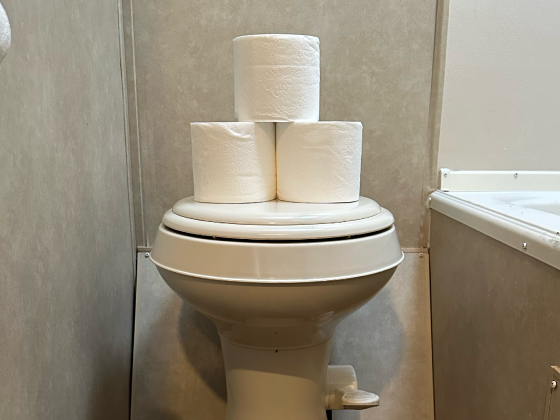Key Points:
- Your RV toilet bowl, black tank and grey tank all need healthy amounts of water
- RV toilet bowls should always have water in them before being used and should be flushed for at least 10 seconds
- RV black and grey tanks require lots of water to control odors, help with waste breakdown, keep sensors clean, and stimulate waste-digesting bacteria
- Consider storing your RV with water and a bacteria and enzyme tank treatment in the black tank when freezing isn’t a risk
Water is incredibly powerful. It can carve out canyons, forge mountain basins, and on a less epic level, it can break up waste and block odors in your RV! Many in the RVing community don’t realize how much of a hero water can be in their RV wastewater systems. Using lots of water is a crucial component to help bacteria-based work as effectively as they are able. Even all by itself, it can steal the show when it comes to softening waste and blocking odors.
All of the following recommendations regarding water usage are covered in The Unique Method, a 50/50 approach to RV holding tank maintenance that requires 50 percent the right care habits and 50 percent the right treatment products to enjoy the best results and avoid all the problems that so many in the RVing community face. Using The Unique Method consistently is always the best way to avoid problems, but in this guide we will discuss specifically why water is extremely important in your RV wastewater systems.
Where Should I Be Using More Water?
There are several places in your RV wastewater systems to use an adequate amount of water:
- In your toilet bowl
- In your black water tank
- In your grey water tank
All of these areas need ample amounts of water to ensure a fully functioning RV wastewater system, and in the following sections, we will discuss in more detail the benefits of using lots of water in each of these areas.
Water and Your Toilet Bowl
Your toilet bowl is probably the most important place to use lots of water because it is the primary way you get more water to your black tank, but using lots of water specifically in your toilet bowl will also add many more benefits to your camping experience.
Fill Your Toilet Bowl Before Using It
Some people go ahead and use their RV toilet before ever adding water to it, which is not a good idea. Let’s put this in the context of a home toilet. Your home toilet always has water in the bowl. Imagine pooping in a dry home toilet bowl (no water); think you’d have some bathroom cleaning to do afterward? You bet. Even though flushing will rinse the bowl, the solid waste has already had a chance to stick to the dry walls of the toilet bowl, which means it will probably take more than a flush to get it off. By filling the toilet bowl with several inches of water before using it, you increase the likelihood of avoiding poop residue clinging to the toilet bowl. No one wants to worry about cleaning a toilet bowl while relaxing in nature, so fill your toilet bowl before you use it to avoid chores like toilet cleaning as often as possible.
Hold down your flush pedal for 10 seconds on every flush
Dry campers and boondockers are often trying to conserve water because they have a limited supply, but even these campers can benefit from using more water when flushing. Just like filling your bowl with lots of water, flushing for at least 10 seconds prevents waste from sticking to the toilet bowl sides and also helps it flow down the pipe easily. Easy flow is very important when you’re trying to avoid clogs in the wilderness, so consider flushing more water as a clog deterrent.
You might think 10 seconds of free-flowing water down the toilet is wasteful, but this allows lots of water into your black tank, which is also crucial to preventing odors. Water is a fantastic odor barrier, so a black tank without enough water can lead to odors in your RV because the solid waste is not covered by water. Yes, using more water could fill your black tank quicker, but solid waste will drop below the water line and spread out in the tank, blocking odors, breaking down waste, and preventing waste pile-up right under the toilet. Just consider which would be more annoying: a quick run to the dump station in the middle of your adventure or having to deal with stinky odors for much of your trip?
Keep Several Inches of Water in the Toilet Bowl at All Times (unless driving)
Water is a highly effective barrier against nasty black tank smells. Home toilets use water all the time as an odor barrier. When your home toilet is not being used and all that’s in there is water, it doesn’t stink, right? Well, the reason for that is because there are two layers of odor protection built in. On the side of the toilet base, you’ll see the outline of a pipe shaped like a P (called a p-trap). The shape of this pipe allows a small amount of water to sit in the low point of the pipe every time your toilet finishes with its flushing process, which prevents sewer gases from coming back up through the pipe. In addition to this, home toilets automatically refill the toilet bowl with water as yet another odor barrier to submerge poop when it is added so the bad odors are trapped under the water until it is flushed.
The same concept applies to your RV toilet. However, most RV toilet lines are positioned directly over the tank or have a slight bend in the line if the tank is not directly under the toilet; because space is a luxury in an RV wastewater plumbing system, it’s unlikely there will be a p-trap in the toilet line. This means that filling the toilet bowl with water after each flush is very important to block odors. You just have to remember to manually add the water to your toilet bowl by pressing your flush pedal down partially so that water begins to flow into your toilet bowl but not so much that the valve opens. Be sure to empty out the toilet bowl of water before you begin driving so that water doesn’t slosh out of the bowl.
Note: If you are dealing with a clog right now, you can find steps on how to clear a clogged RV toilet in our guide on Clearing RV Toilet Clogs.
Water and Your Black Water Tank
The best way to keep clogs and odors a non-issue in your black water tank is to use tank treatments that include high-quality aerobic bacteria, which is a type of bacteria that help curb odors and break down waste. These bacteria must have ample amounts of water to survive and even reach all the waste, so generous amounts of water in your black tank may feel wasteful or like it’s filling up your black water tank sooner than you want, but it will help deter other problems that may be much more annoying than pausing your trip to dump a full tank.
Note: For more details on why it is important to have a healthy colony of aerobic bacteria in your wastewater holding tanks, refer to the Why Are Bacteria and Enzymes Good in RV Holding Tanks guide.
In the following subsections, we will discuss the important role water plays in your RV black water tank(s).
Keeps Waste Soft
Continually having water in your black tank while in use is essential to avoiding clogs by keeping waste soft and water-logged. Without water, solid waste and toilet paper will pile up and dry out. For this reason we always say leave your black valve closed unless actively dumping a full tank. If the valve is left open even occasionally, any liquid you add will always run out right away, leaving a building pile of poop right under the toilet line, which can easily become a pyramid plug. If you keep your black valve closed and add plenty of water every time you flush your toilet, the likelihood of waste solidifying will drop dramatically. Water is important to the breakdown process of waste because it softens the waste and promotes breakdown into smaller pieces, but aerobic bacteria and enzymes go a step further in the breakdown process (see next section).
Guide: Why It's Crucial to Keep Your RV Black Water Valve Closed
Helps Bacteria-Based Treatments Work Effectively
No RV black water tank treatment plan is complete without a waste digesting product to break down the solid waste in your tank. We suggest that you use a high-quality, bacteria and enzyme RV holding tank treatment, like Unique RV Digest-It Plus, since this type of product works best to liquefy waste and keep odors under control. But even top-notch waste-digesting products will fail if there isn’t enough water in your tank. The fundamental ingredient of high-quality waste digesters is aerobic bacteria, and they need plenty of water to stay well-hydrated (they don’t survive without water). They will not efficiently digest waste if they do not have enough water and they won’t be able to reach all the waste because water is the pathway on which they travel. And as we said in the last subsection, water keeps the waste water-logged and soft, something that helps the bacteria more easily break it down.
Guide: Why You Should Use a High-Quality Waste Digester in Your RV
Helps Suppress Odors
Water is a great barrier for odors not just in the toilet bowl or a p-trap, but also in the black water tank itself. When you have enough water in your black water holding tank, it covers the solid waste, which causes it to sink to the bottom instead of building into a tall pile; if you have enough water in the black tank to cover every piece of poop, this will act as another odor barrier in addition to the water in the toilet bowl. Because many RV toilets are directly over the black water tank, they tend to not have a p-trap in the line, so ensuring the presence of lots of water in your black water tank is like applying the concept of a p-trap to block odors.
Note: Refer to the Keep Several Inches of Water in the Toilet Bowl at All Times subsection for more details on the function of a p-trap.
Water and Your Galley/Grey Water Tank
Water usually ends up in your grey or galley tank a number of ways:
- Washing hands
- Showering
- Washing dishes
Many times, dry campers/boondockers use as little water as possible when cleaning dishes or washing anything because they don’t want to have to dump in the middle of the trip. However, in the next few subsections, we will discuss a few reasons to try to use a little more than you might want to, even while dry camping/boondocking.
Helps with Sensor Care
The more water you use, even in your RV grey water holding tank, the less likely grease and food particles will affect your sensors. When you wash your dishes (even after having wiped them of food particles and grease), there is still grease that makes it into the tank. Even shampoo and soap can leave greasy residue in the tank by virtue of how they are made. The less you allow in there, the better, but more water will help disperse the bit that does make it in there and prevent sensors from being coated by grease, which can easily cause them to misread.
Helps Bacteria-Based Treatments Work Effectively
Even grey water tanks benefit from receiving a bacteria and enzyme holding tank treatment, in which case, the grey water tank also needs ample amounts of water to keep these bacteria healthy and breaking down waste. Yes, products like Unique RV Digest-It Plus can also help break down grease waste, so consider using them in your grey water or galley tanks as well.
Rinses Discharge Line
It may seem trivial, but having lots of water in the grey water tank will allow you to effectively rinse the discharge line after dumping the black tank. Like killing two birds with one stone, dumping the black tank first will ensure that the black water residue in the discharge line is rinsed by simply dumping the grey tank. Off you go without any additional rinsing needed!
Storing Your RV with Water in the Black Tank
We know, we always say make sure your tanks are dumped and rinsed before storing your RV, and we stand behind that recommendation. However, if you know there will be no risk of freezing, we recommend storing your RV with a black tank(s) full of water and a bacteria and enzyme tank treatment, like Unique RV Digest-It Plus. By doing this, you are allowing the bacteria to have a lot more time to work on breaking down any residual waste still on the holding tank walls, floor, or sensors so that everything is as clean, clog-free, and odor-free as possible when you go to use it the next time. Don’t rule out this recommendation if you live in a place where there will eventually be freezing temperatures; we still recommend storing it with a full black tank of water and a bacteria-based treatment. Just dump it before the freezing weather arrives. Even a shorter storage period with water and a bacterial tank treatment will provide huge benefits in the long run.
Review
We always recommend using The Unique Method as a guide for the most effective RV holding tank maintenance because it is a 50/50 approach; 50 percent the right habits and 50 percent the right products. We also advise using Unique products in conjunction with The Unique Method since our products were designed to work most effectively with it.
Here’s a brief review of what we covered in this guide:
- Water in your toilet bowl:
- Fill your toilet bowl before using it
- Flush your toilet for 10 seconds every time
- Keep several inches of water in the toilet bowl at all times (unless driving)
- Water in your black tank(s):
- Keeps waste soft
- Helps bacteria-based treatments work effectively
- Helps suppress odors
- Water in your grey/galley tank(s):
- Helps with sensor care
- Helps bacteria-based treatments work effectively
- Rinses discharge line
- Storing your RV with water and a bacteria-based treatment in your black tank(s) is recommended (when freezing temperatures are not predicted)

Prevent Common Problems In Your Tanks!
From misreading sensors, preventing clogs, or eliminating odors, we've got you covered no matter how you camp! All our best holding tank tips and trick information plus more can be found conveniently in one place when you download our FREE Unique Method Field Guide. Achieve holding tank bliss today!
Get The Free Download



